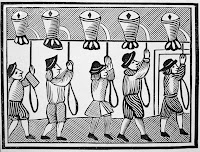For example: bells.
I live half the year (the cold half) in San Miguel de Allende, an ancient colonial town in central Mexico. There are many, many churches, and all of them have bells, and the sound of those bells is a beautiful part of life here. It evokes, for me, a hint of what life must have been like in the past: the sound of horse hooves on cobblestones, the deep resonance of church bells.
In The Discovery of France I've learned more about the importance of bells. When a bell was being cast, for example, villagers would add their personal mementos to the metal: coins, candlesticks, plates. They became part of the bell — their village voice.
 Bells marked the hour and important events: the harvest, the departure of domestic animals for winter pasture.
Bells marked the hour and important events: the harvest, the departure of domestic animals for winter pasture.(Image at left: 17th century woodcut of men ringing bells. )
Bells chased away witches and warned of danger (which recalls to mind the air-raid sirens of my youth). The sound of a bell ringing was believed to protect against thunder and hailstorms (hence the poor bell-ringers who died in a storm). The sound of a village bell served as a guide when the weather was foggy.
Bells marked out territory. The size of the bell and the height of the bell tower were a good indication of the extent of the village: one lived within hearing distance of the village church bell.
So now, when I listen to the bells of San Miguel, I wonder what personal trinkets went into them — tiny Milagros, no doubt: miracles.
-----
Sandra Gulland
www.sandragulland.com